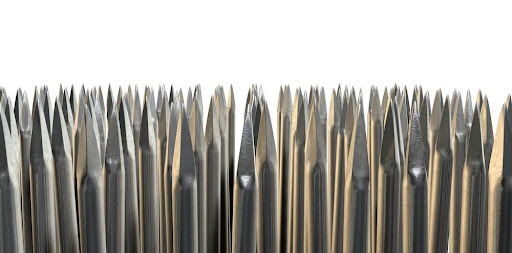Artificial grass is often marketed as a low-maintenance, environmentally-friendly alternative to natural turf. However, the production of synthetic turf has many negative environmental impacts, and it is far from maintenance-free. So let’s take a look at some of the claims of plastic grass manufacturers, and see if the claims match the reality.
Table of Contents
Low Maintenance?
Artificial grass is often marketed as a “maintenance-free” alternative to real grass. However, this couldn’t be further from the truth. Artificial grass needs to be hosed down frequently to remove dust and dirt and regularly swept to keep it looking its best. Some people even vacuum their fake lawns every couple of weeks.
Moss and algae can quickly take hold in artificial turf, meaning you may need to use moss-killing chemicals from time to time. Artificial grass can even get moldy! And let’s not overlook the fact that if you have pets, you will have to work hard to prevent them from using the artificial grass as their bespoke bathroom. The last thing you want is to have to clean cat urine or dog mess from each blade of plastic.
In short, if you’re looking for a low-maintenance option, artificial grass is not it!
Environmental Harm
Unfortunately, this trend comes with some serious environmental consequences. Artificial grass is typically made from a synthetic polymer called polyethylene. This material is not biodegradable, meaning it will sit in landfills for centuries.
The production of artificial turf also requires large amounts of energy and water, and manufacturing artificial turf creates significant carbon emissions, contributing to climate change. In addition, artificial turf can increase temperatures in urban areas, creating an “urban heat island” effect. As a result, cities with large amounts of artificial turf may be several degrees warmer than surrounding rural areas. Artificial turf also interferes with the natural water cycle, as it prevents rainwater from seeping into the ground. This can lead to increased flooding during heavy rains.
Then there’s the fact the installers of artificial grass often remove native plants and replace them with synthetic turf, which can disrupt local ecosystems.
Finally, artificial turf can be extremely hot in direct sunlight, making it uncomfortable to use while causing direct harm to local wildlife. The alternative, which is to create a pollinator garden, is simply better for the environment in every way.
For all these reasons, it’s important to think twice before choosing artificial turf. There are many more sustainable and eco-friendly options available that won’t have such a negative impact on the environment.
Health Risks
There are serious concerns about the health risks associated with artificial turf. The tiny plastic blades making up artificial turf can prickle and cut skin, and the infill material (usually rubber granules) can be a source of chemicals that may be harmful if inhaled or ingested. If you have young children or pets, they may be at risk of injury from artificial turf.
These materials are not only non-renewable but also release harmful toxins into the environment during manufacturing and disposal. These chemicals can cause respiratory problems and skin irritation. There are also ongoing legal discussions and arguments about how much the chemicals used in artificial grass can cause cancer, although this has yet to be proven either way.
Replace and Recycle?
Artificial grass has come a long way since it was introduced in the 1960s. Today, many different types and styles are available, each with its own “benefits.” However, one understated downside of artificial grass is that it will eventually need to be replaced.
Most artificial grass products have a lifespan of 10 to 15 years, after which they will start to break down and lose their aesthetic appeal. And artificial grass is not always easy to recycle. Although it can be done, the process is usually more complicated than manufacturers claim.
The fake lawn war has been going on for years, and it’s easy to see why garden owners would get confused by all of the claims made by unscrupulous sellers of plastic grass. They limit or contort the available information, turning downsides into selling points.
The situation is getting so bad that the Royal Horticultural Society in the UK has recently announced it has banned artificial grass at its world-famous Chelsea Flower Show. This is a sign of the times and hopefully an indication that plastic grass is reaching the end of its popularity.
Artificial Grass and Nature
Artificial grass lawns might look pristine and perfect, but they can devastate local wildlife and ecosystems. As well as chemicals that can leach into the soil and pollute waterways, the turf also provides no food or shelter for animals, and the plastic fibers can be harmful if ingested.
Artificial turf can also become incredibly hot in the sun, making it unsafe for animals to walk on. As a result, artificial turf lawns often create “dead zones” where no wildlife can survive. Not only is this bad for the environment, but it can also have a ripple effect on the entire food chain.
We rely on pollinators like bees and butterflies to help us grow crops; without them, our food supply would be in jeopardy. So next time you’re considering artificial turf for your home, think about the negative impact it could have on your local ecosystem.
Artificial Grass and Our Connection with Nature
As the world becomes more urbanized, we are losing touch with nature. It’s more important than ever that we take time to reconnect with the world around us. We are amidst a biodiversity crisis, with plant and animal species disappearing at an alarming rate. One obvious solution is to get rid of the plastic grass and focus on native plants and grasses.
Artificial grass doesn’t provide any habitat for wildlife or help filter pollutants from the air. So let’s ditch the fake grass and create green spaces that are good for people and the planet. Plastic grass isn’t just hurting the wildlife around us; it’s harming us too. After all, your children won’t be able to make a daisy chain on a plastic lawn.
Artificial grass requires a lot of energy to produce and is not biodegradable. Natural grass, on the other hand, is environmentally friendly and requires very little energy to produce. It is also biodegradable, making it a more sustainable choice in the long run. In addition, real grass helps to purify the air and regulate temperatures, making it a cooler and more comfortable place to spend time during hot summer days. For these reasons, real grass is a better choice than artificial grass for both the environment and personal comfort.
The Real Dilemma
While artificial grass has some benefits, the concerns outlined above suggest that it may not be the best choice for everyone. So if you are considering installing artificial turf, please consider these concerns before making a decision.
However, we believe there’s a bigger question that needs to be addressed, and that’s whether we should be utilizing lawns at all. The All-American lawn might symbolize US prosperity, and they may create a more symmetrical, looked-after appearance, but is that what we want?
The lawn is an archaic, harmful, and wasteful approach to our outdoor spaces. It‘s time to rethink what we do with our yards and lawns to better reflect our connection with the natural world. In a time when monarch butterfly populations are dwindling and where invasive species threaten the natural biodiversity of our states, it’s time to fight back. Native plants that encourage local wildlife to thrive are the obvious solution to the crisis facing the ecology of the United States.
So the question isn’t whether plastic or artificial grass is best for your lawn. Instead, we should ask what we will do about this desperate need to control the world around us. Replace that lawn entirely using a native plant finder, and fill your garden with butterflies, fireflies, and other species vital to the future of our ecology.


















